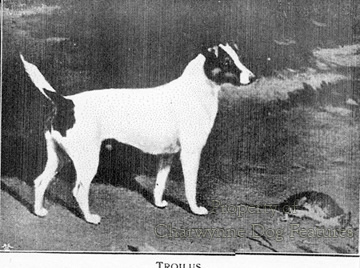1015 THE SOMERSET AND DORSET HUNT TERRIERS
THE SOMERSET AND DORSET HUNT TERRIERS
by David Hancock


Late Victorian and Edwardian times, in the south of England, were the heyday of the working terrier, the Fox Terrier in particular. On Dartmoor and Exmoor, terrier-men like Tom Rubie, Arthur Heinemann and the Rev John Russell, were fashioning memorable dogs but in adjacent Somerset and in Dorset, lesser-known enthusiasts were at work too. Two remarkable sporting ladies, Alys Serrell and Augusta Guest, were breeding outstanding sporting terriers, combining the blood of the dogs of Russell and the Nottinghamshire-based Grove line. Nowadays, the landed gentry play little part in breeding sporting dogs; in these times, they led - with these two extraordinary ladies leading the way. We are fortunate that one of them, Alys Serrell, wrote extensively about her dogs, in her With Hound and Terrier in the Field of 1904 especially. She hunted mainly with the Blackmore Vale. She wrote with the confidence of her class but very honestly and with acquired knowledge.


In her book, writing on the Fox Terrier, she states: "It is unfortunately true that we have tried hard to spoil him. On the one hand, he has been treated as a mere household pet, and thus become so soft that he has lost all taste for sport; and on the other hand he has been made an instrument of show-bench extravagance. There are fox-terriers with heads so long and narrow as to leave no room for brains; so high on the leg they cannot go into a fox or badger earth without being crippled for cramp; or again so flat-sided as to have no stamina." She would have hated the exhibits in today's show rings. She wanted her dogs to function! She favoured a terrier 'not much over 14 inches or weighing more than 18lbs'. Today the Kennel Club expects this breed to be not over 15 and a half inches high and 18lbs in weight. It also seeks a dog with a 'moderately narrow skull' - whatever that means!


The tap-root of the Serrell terrier kennel was Redcap (born 1880), a 16lb dog, compact in build with a short, hard, dense coat, rated by the huntsman of the Blackmore Vale hounds as the best terrier he ever came across. She bought in Sharper from Wootton of Nottingham, an 18lb dog, grandson of the famous Old Foiler, by Troilus out of Grove Nettle, all celebrated hunt terriers. Her favourite bitches were Amber (a great-granddaughter of Russell's renowned Old Tip), who produced the top hunt terrier Trojan, by a Sealyham (renamed Ranter), and her daughter Rosa, to found her highly-rated kennel. Her kennel signature, a mainly white dog with coloured (usually black and tan) ears, can be seen in Floss, Racer, Redtop and Roy. Alys Serrell was a great admirer of Augusta Guest's terriers, effective earth-dogs such as Ranee, a thick-coated, undocked dog; the Guest terriers were never docked and usually featured the closer, denser wire-coat now a lost feature of the modern breed.


For Alys Serrell a working terrier had to be responsive to training, only then did she look for the physical attributes she was looking for. The anatomy she sought was: a strong square jaw, with good big level teeth, a black nose, small drop ears and dark eyes, displaying eagerness and spirit; a deep chest but not a wide one, sloping shoulders and power in the hindquarters. She especially looked for well-defined muscle and sound digging feet - strong pads, tough toe-nails and a compact construction. She valued a level back, an erect tail and a crisp hard coat texture. She would not have liked the soft woolly coats in show terriers today or the required long narrow snout, more ant-eater than terrier! She never applied the same training regime on every dog, striving to hone an individual programme to suit the nature of the dog being schooled. She admired terriers that 'persevered' and didn't 'switch-off' during periods of little activity, favouring the ones always waiting to work. She trained her pups on otter by using a tame one to 'enter' them. Her house-dog Floss , working with Sharper, became a very efficient otter terrier.


Alys Serrell had firm views on training terriers, writing: "You must devote time to study his disposition and peculiarities, and he must learn to know and understand you, or there will be no basis for the goodwill and friendship without which you can never hope to make the best of him. The most important step will have been taken when you have gained his confidence, for a dog ruled by fear seldom shows intelligence...It is important to remember what an excitable animal a terrier is, and to be very quiet in voice and manner with him." She hunted her terrier pack in 7-12 couples and so too great a frenzy in the field would have spoiled her sport. In the hunt, she was a great advocate of letting the terriers run with the hounds, in the Border Terrier style. It is interesting to read of her top priority for coat, texture not colour, in her breeding plans, finding that a poor coat penalised the gamest of terriers. Every working terrier enthusiast would be wise to heed the experienced words of Alys Serrell; she and he neighbouring terrier-fancier Augusta Guest, would have despaired of the show ring Fox Terriers winning rosettes in KC rings today.